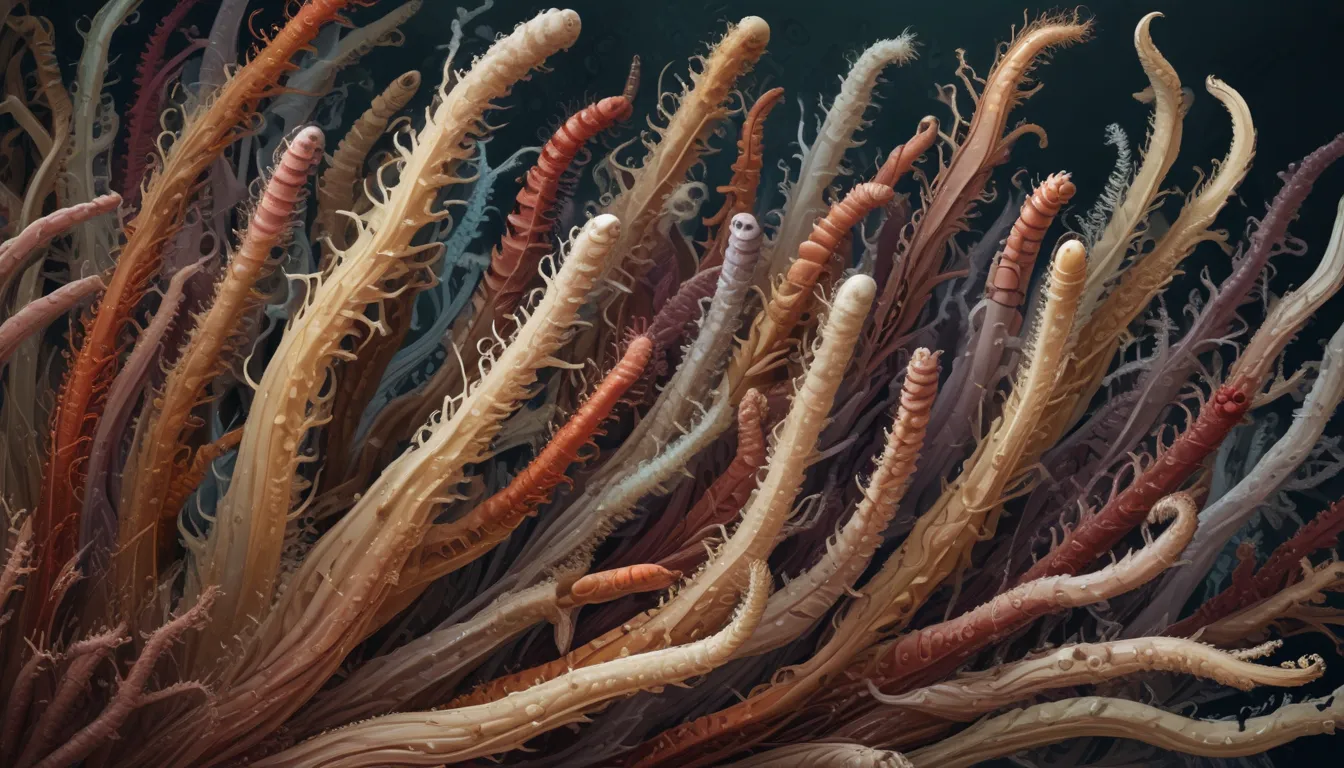The pictures we use in our articles might not show exactly what the words say. We choose these pictures to make you interested in reading more. The pictures work together with the words but don’t take their place. The words still tell you the important facts.
Welcome to the mysterious world of tube worms, where these mesmerizing creatures thrive in the depths of the ocean, captivating marine biologists and nature enthusiasts alike. Known for their unique adaptations to extreme deep-sea environments, tube worms, also known as polychaete worms, are truly remarkable organisms that call the ocean floor home. In this article, we will embark on an underwater journey to uncover 19 intriguing facts about these enigmatic animals, from their symbiotic relationships with chemosynthetic bacteria to their crucial role in deep-sea ecosystems. Let's dive in and discover the wonders of tube worms beneath the waves.
Discovering the World of Tube Worms
- Marine Invertebrates: Tube worms belong to the phylum Annelida and are commonly found in deep-sea environments, showcasing their fascinating adaptations to survive in the ocean depths.
- Unique Appearance: These creatures have long, thin, tube-like structures made of chitin, a tough protein substance that forms a protective casing around their bodies, giving them a distinctive appearance.
- Impressive Sizes: Some species of tube worms can reach lengths of up to six feet, making them one of the largest types of worms in the world.
Survival Strategies of Tube Worms
- Symbiotic Relationships: Tube worms form mutualistic relationships with bacteria living inside their bodies. These bacteria provide nutrients to the worms, while the worms offer a protected environment for the bacteria to thrive in.
- Filter Feeders: Using their feathery appendages called radioles, tube worms filter tiny particles of food from the water around them, showcasing their unique feeding strategy.
- Adaptation to Deep-Sea Environments: Tube worms possess specialized hemoglobin molecules that can bind and transport oxygen even in low-oxygen environments, allowing them to thrive in extreme conditions.
- No Digestive System: Instead of a digestive system, tube worms rely on the bacteria they host to break down and digest their food, demonstrating their reliance on symbiotic relationships for survival.
Role of Tube Worms in Deep-Sea Ecosystems
- Underwater Oases: Tube worm colonies can create dense aggregations that provide habitats for a wide range of other deep-sea creatures, contributing to the biodiversity and functioning of these fragile environments.
- Reproductive Strategies: Tube worms can reproduce sexually or asexually, releasing eggs and sperm into the water for external fertilization or producing clones of themselves through budding or fragmenting.
- Critical Ecosystem Players: By creating habitats and recycling nutrients, tube worms play a crucial role in deep-sea ecosystems, enriching and sustaining the marine environment.
Fascinating Behaviors and Characteristics of Tube Worms
- Free-Swimming Larvae: After hatching from eggs, tube worm larvae spend time swimming in the water column before settling on the seabed and growing their characteristic tubes, showcasing their unique life cycle.
- Habitat Diversity: Tube worms can be found near hydrothermal vents, cold seeps, whale falls, and other deep-sea environments rich in organic matter, highlighting their ability to adapt to various habitats.
- Extreme Conditions: Tube worms have a high tolerance for extreme conditions, including high pressures, low temperatures, and toxic substances, allowing them to thrive in harsh environments.
- Long Lifespan: Some species of tube worms have been found to live for up to 250 years, making them one of the longest-living invertebrates on Earth, demonstrating their longevity and resilience.
Scientific Insights and Technological Innovations
- Source of Scientific Interest: Scientists study tube worms to better understand their unique adaptations and potential uses in fields such as biotechnology and medicine, highlighting their importance for scientific research.
- Bioluminescent Displays: Some species of tube worms release bioluminescent chemicals during spawning events, attracting other organisms and showcasing their fascinating reproductive strategies.
- Technological Potential: The ability of tube worms to thrive in extreme conditions has inspired scientists to explore their biology for potential applications in the development of resilient materials and bioengineering, unlocking new technological innovations.
Global Presence and Awe-Inspiring Beauty
- Worldwide Distribution: From the Atlantic Ocean to the Pacific Ocean, tube worms can be found in deep-sea locations across the globe, reflecting their widespread presence in diverse marine environments.
- Mesmerizing Beauty: With vibrant colors, intricate structures, and graceful movements, tube worms add beauty and diversity to the deep-sea ecosystem, captivating observers with their enigmatic charm.
In conclusion, tube worms are captivating creatures that have adapted to survive in the challenging depths of the ocean, showcasing unique characteristics and behaviors that make them truly remarkable. From their symbiotic relationships with bacteria to their vital role in deep-sea ecosystems, tube worms continue to intrigue scientists and nature enthusiasts alike. Whether you are a marine biologist or simply curious about the wonders of the natural world, exploring the world of tube worms is sure to be an awe-inspiring journey filled with discoveries and marvels. Stay tuned for future research and revelations as scientists uncover the secrets of these incredible animals.
FAQs About Tube Worms
-
What are tube worms?
Tube worms are marine animals belonging to the phylum Annelida, known for their unique adaptations to survive in extreme deep-sea environments. -
Where can tube worms be found?
Tube worms are typically found in deep-sea hydrothermal vents, cold seeps, and whale falls, thriving in environments with specific conditions for survival. -
How do tube worms obtain nutrients?
Tube worms have a symbiotic relationship with chemosynthetic bacteria that convert chemicals into organic compounds for the worms to absorb as nutrients. -
How do tube worms reproduce?
Tube worms reproduce by releasing eggs and sperm into the water, where external fertilization takes place, leading to the development of larvae that settle and grow into adult tube worms. -
What is the lifespan of tube worms?
The lifespan of tube worms varies among species, with some living for several decades and others having shorter lifespans, reflecting the diversity in their life cycles. -
Are tube worms harmful to humans?
Tube worms are non-aggressive and do not pose a threat to humans, lacking venom or stinging mechanisms. It is essential to respect their natural habitats and avoid disturbance. -
Can tube worms be kept in aquariums?
Keeping tube worms in aquariums is challenging due to their specific environmental requirements and symbiotic relationships, making it uncommon to find them in home aquariums.
Our commitment to delivering accurate and engaging content drives our dedication to providing trustworthy information on tube worms and other fascinating topics. Each fact shared on our site is contributed by real users, ensuring a wealth of diverse insights and knowledge for our readers. Explore the wonders of tube worms with us, and trust in our commitment to quality and authenticity as we continue to uncover the secrets of these incredible creatures.






